How To Get Rid Of Pantry Moths Naturally - 10 Steps To Pantry Moth Control

A really common question customers ask is “How do I get rid of Pantry Moths in my house?"
The rapidly increasing presence of pantry moths in our homes brings with it a serious risk of food contamination with moth larvae in food containers and small flying moths in your kitchen. This brings with it an overall concern for kitchen hygiene.
Hopefully you will find the resources on this website helpful in increasing your understanding of your pantry moth infestation, pantry moth treatment, as well as giving you the knowledge to go about eradicating pantry moths from your kitchen or pantry using products like pantry moth traps.
If you suspect a pantry moth infestation in your home, the number one thought should be, act fast; pantry moths breed rapidly as the pantry moth life cycle is short, so you may be alarmed at how quickly they multiply.
With this guide you'll be able to get rid of pantry moths in your pantry, kitchen and home taking control in the role of the pantry moths exterminator.
Are pantry moths harmful?
Pantry moths aren't reported to sting or bite, however they are a nuisance and having pantry or kitchen moths in food cabinets increases the risk of eating tiny moth larvae - for example it's common to discover moth larvae in rice, flour or open packets for bird seed. The best solution? A combination of proper food storage and moth traps designed for food moths.
You may now be wondering are moths edible?! This isn't something we'd advise and all the more reason to get to your pantry moths treatment plan - killing pantry moths, pantry moth eggs and the pantry moths larvae.
Step 1 - Regularly check your Pantry
The chances are that if you’re reading this then you’ve already found signs of pantry moths and you're asking yourself why do I have moths in my pantry?! And where do pantry moths come from?
It's all too easy for us to have out of date food stored at the back of over-crowded shelves and left undisturbed for long periods of time, making perfect conditions for moth larvae to thrive. That’s why regular checks and using moth prevention traps is essential.
Checking what you have and the act of moving pantry contents around will immediately have the benefit of ensuring you are not providing a safe, undisturbed environment for pests resulting in moths in the pantry and kitchen cupboards.
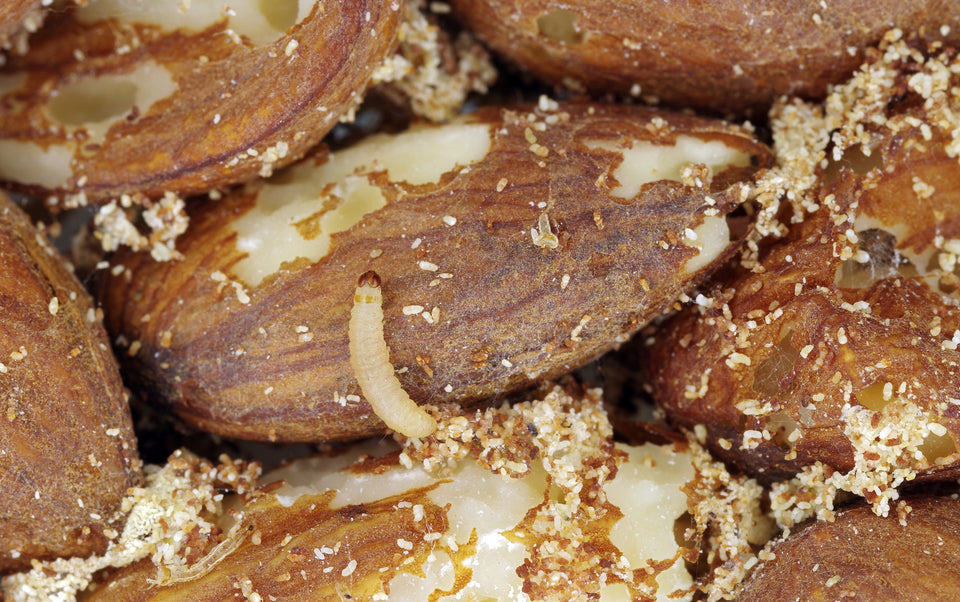
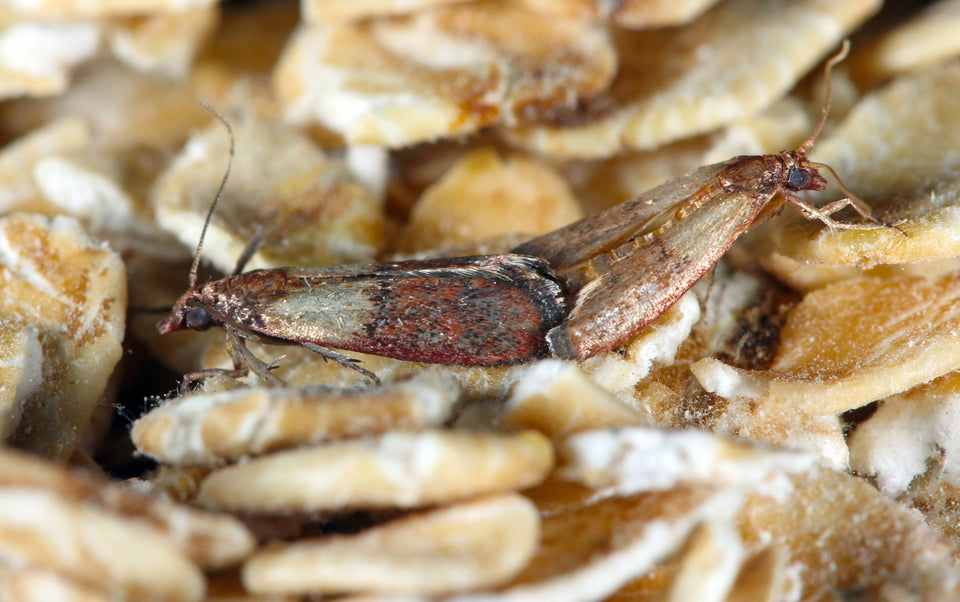
Step 2 - Check all food stored in your Pantry for Moths
When you are checking your pantry, you can inspect each food container or bag individually - both for the use by dates and whether there are any ‘unwanted visitors’ residing there. Consider placing moth traps near suspect areas.
What are you looking for? Pantry moths may be present in flying adult form or in the earlier pantry moth life-cycle stages (eggs and larvae).
Which foods are at high risk? Pay particular attention to cereal and grain based products. For example, breakfast cereals, oats, flour, pasta, lentils, popping corn, rice, nuts.
Dry foods for your pets, such as biscuits, are especially at risk as they tend to be stored in large bags that are not easy to reseal and keep moths out! And if you feed the wild birds in your garden don't forget to check the bags of seed, grain and nuts that you might have stored in your garage or garden shed!
This is another reason pantry moths can also be referred to by names such as; bird seed moth, flour moths, grain moths, wheat moths, food moths, cereal moths or even rice moths.
Pantry moth larvae are small but far easier to identify than food moth eggs - they’ll be between ¼ and ½ inch long, and you may see some movement in the food. If you spot this, act immediately with pantry moth prevention and set up pantry moth traps.
What attracts pantry moths is the presence of open food containers in which they can lay their eggs. If food isn't regularly disturbed and moved around, the flying pantry moth may go unnoticed enabling effective breeding, eggs developing into pantry moth pupa or larvae and on to their adult flying form. Using pantry moth traps early can help detect their presence and interrupt the cycle.
We've detailed out the pantry moth life cycle in another handy MothPrevention guide to the life cycle of pantry moths.
Step 3 - Dispose of all Pantry Moth-infested Foods
Foodstuffs in their original packaging that are out of date and / or infested should be disposed of as they are. This is the pantry moth removal stage of the process. Similar foods in reusable containers should be disposed of carefully and the container retained for cleaning.
Even if you have stored your food in mason jars or kilner jars, it is worth checking in case they had been placed back in the pantry or cupboard with the lid not fully sealed and those nuisance cupboard moths got in. If this was the case you may leave a future source of potential meal moth infestation in place!
Also carefully check dried pet food and for moths in bird seed - common sources of pantry moth infestation.
Disposing of infested food should be done outside the home to avoid the risk of spillage and future re infestation - place infested and old food in bags that are then tied securely. Getting rid of infested food means you're on the path to getting rid of meal moths, but we're only part way through our journey to getting rid of pantry moths for good.
Step 4 - Clean Your Containers
Rinse, disinfect and then thoroughly wash reusable food storage containers, either carefully by hand, or on a hot setting in your dishwasher. This is one of the most effective ways to implement moth larvae prevention.
If you were wondering how to kill pantry moth larvae and eggs - then a thorough clean of containers with hot soapy water will rid you of any remaining pests that weren't thrown out with the infested food. Complement this with pantry moth prevention products and regular use of pantry moth traps to ensure they don't return.
This is a vital step to pantry moth eradication that must not be missed. Pantry moth eggs are tiny and easily missed by the human eye!


Step 5 - Clean out your Pantry / Kitchen Cupboards
With all shelving clear of food and containers, start by vacuuming all surfaces and paying particular attention to signs of moths in cupboard corners, cracks and crevices. Please do not forget the undersides of shelves, baseboards and floors, where pantry moth larvae or pantry moth eggs may be hiding.
It's easy to spot adult flying pantry moths in kitchen cabinets, but less so to spot the pantry moths eggs. Getting rid of moths in kitchen cupboards means getting rid of their eggs too!
Like with foodstuffs, empty your vacuum cleaner outside the home emptying the contents into a bag that you then seal / tie tight. Remember that there may be tiny pantry moth eggs in amongst the dust in addition to, potentially, moth webbing, cast off skins and pantry moth cocoon carcases.
Note that when emptying your vacuum, if it is a bagless type, you will want to wash out the dust container. If you have used smaller attachments you may also want to clean those thoroughly to ensure any sticky pantry moth eggs do not remain and are not reintroduced later — this step supports thorough carpet moth prevention efforts if any have travelled beyond the kitchen area.
Then wash down your shelving and all surfaces using a disinfectant or watered down bleach and leave to air dry.
Commonly, what causes pantry moths to re-appear is a lack of thorough cleaning at this stage - so invest in doing this extensive clean and you'll likely only need to do it once - as opposed to a few weeks down the line wondering why are there moths in my pantry again?
You may find our article on pantry organization tips helpful.

Step 6 - Deal with Shelf Liners
With paper-based shelf liners, throw them out because they may be harboring pantry moth larvae and/or eggs and essentially be a perpetual pantry moth nest contributing to a recurring pantry moth infestation.
If they are plastic, they may be washed and scrubbed thoroughly in soapy water.
It’s best not to replace your shelf liners until you are sure that your pantry moth extermination is complete, or consider not using them at all.
Step 7 - Set up Pantry Moth Traps to Defend and Monitor
Pantry moth traps have two main functions:
- First they will provide effective monitoring to see if pantry moths are present in the future. Remember that they last 8 weeks and will need replacing regularly.
- Secondly they use a female pantry moth pheromone to attract the male pantry moths and trap them on the sticky glue board in the trap. When the adult male moths are trapped, it reduces the rate of reproduction and reduces the risk of another full-blown infestation in the future (arguably there's no such thing as a small moth infestation).
Step 8 - Refer to our Pantry Moths Kit Guide for advice on persistent infestations
If you have a large persistent pantry moth infestation you may like to consider Residual pesticides which come in many forms but are broadly either chemical or natural - in kitchens you should only consider natural residual sprays for pantry moths, especially when safety around food and family is a concern.
Natural sprays to deal with pantry moths and pantry moth larvae or maggots may only be effective for 2 weeks after application and can be deemed a way of getting rid of pantry moths naturally whilst keeping your family safe from chemicals.
Please read our Panty Moths Kit Guide for further information.
Step 9 - Replace non-infested food
Non-infested as new food should all be placed into airtight, sealed containers - plastic food storage containers or glass jars such as mason jars or kilner jars. This is how to keep moths out of food effectively for the long term.
This is especially important for cereals, grains, flour, dried fruits, nuts and rice but you should consider this approach for all foods that are not already in sealed tins or containers.

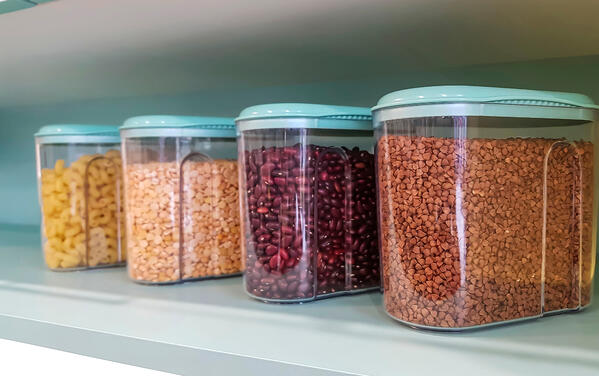
The most common pantry moth species is the Indian meal moth but you may also come across the Mediterranean flour moth. Check out our kitchen moth identification guide if you need further details.
Pantry Moth Pheromone traps to catch and kill pantry moths are a critical part to answering how to get rid of pantry moths forever.
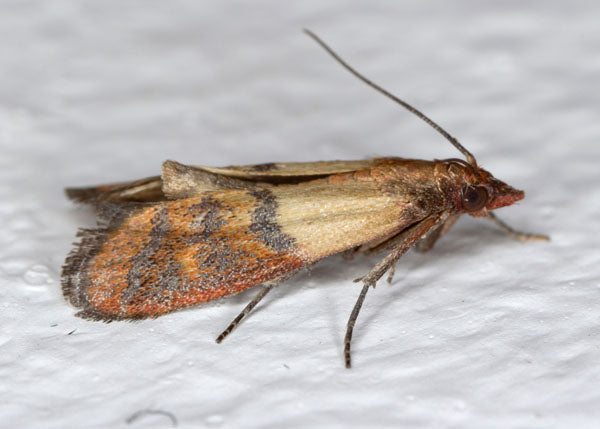
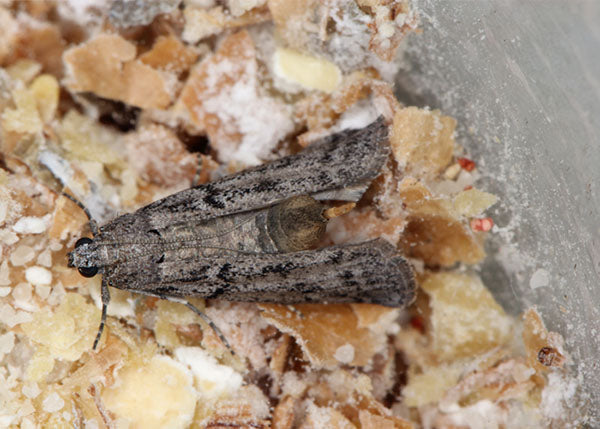
Step 10 - Be Ever Vigilant!!
As they say, “Once bitten, twice shy” … keep alert and use some of the advice above to maintain your pantry and food cupboards.
In particular:
- Keep reviewing your pantry contents regularly for out of date food and to ensure there are no undisturbed areas
- Keep all foods in airtight protective containers
- Wash down shelves and vacuum periodically
- Use pantry moth traps to monitor, especially in warmer months - pantry moths start to pupate and develop as flying adults in the early spring season - female pantry moths typically lay up to 200 eggs and there can be 2 to 4 breeding cycles per year
Identifying Pantry Moths
There are four types of food moth (or pantry moth) to look our for within your kitchen.
The most common pantry moth species you might come across is the Indian meal moths but you may also come across the Mediterranean flour moth, Brown House Moth and White Shouldered House Moth.
All will settle where there is a supply of food, resulting in an infestation where larvae can soon become a serious problem. With a single female moth able to lay up to 600 eggs, an infestation if left untreated can result in the expense of food wastage, as well as hygiene issues for your family. Click on the images below for more information about each species.
Preventing Pantry Moth Infestations
We hope this article has answered the question “How do I get rid of Pantry Moths?”.
It may feel like a lot of work to do this thoroughly, and some expense, but it will save you money in the long run and avoid a hygiene problem getting out of control.
If all else fails,you could ask a professional pest controller to apply a treatment although with pantry moth pheromone traps and some work in vacuuming/cleaning, it should be relatively inexpensive to get rid of pantry moths yourself.
How to use MothPrevention Powerful Pantry Moth Traps / how long to use them?
Do you suspect that you have Pantry Moths and are wondering how to get rid of them? Pantry Moths, also known as Indian Meal Moths, tend to infest specific areas within the home. Namely, they invade your pantry. So one of the first steps is to identify that this is the type of moth you are dealing with.
If you are seeing moths flying around your kitchen area or have discovered small worm-like larvae in your grains and dry foods then chances are that you are dealing with Pantry Moths. The female moths will lay their eggs near a suitable food source for their hungry larvae, so unsealed bags and boxes of cereal, rice, flour, even chocolate are on the menu!
Put Fresh MothPrevention Pantry Moth Traps Near Activity "Hot Spots"
Follow the instructions on the package to set up the moth trap.
The Pantry Moth Traps attract the sexually active adult male moths to the powerful pheromones on the sticky strip. By catching the active males the breeding cycle is being interrupted and the presence of moths will be reduced over time.
Your pack contains 15 traps. Position the traps in areas where infestations are present. If you are unsure about how many traps to use at first, start with one or two traps in each area and monitor for moth activity. If the trap is catching a lot of moths in a short space of time you may need to use more than one.
Check Pantry Moth Traps Weekly Until the Infestation is Under Control
Once opened the traps remain active for 8 weeks so checking them weekly will give you a good indication of the extent of your moth problem. Moth control is not an overnight undertaking. Ergo, you are going to need to stay on top of things for a few months at least and check your traps regularly.
You can move the traps to different locations depending on where moths are present.
Do not place other deterrents nearby as they can distract from the Traps.
Maintaining and Replacing MothPrevention Pantry Moth Traps
Once your infestation is under control, you should continue using Pantry Moth Traps to prevent reinfestation from happening. Keeping one “sentinel” moth trap placed near the back of your pantry is a smart idea. After all, if you have had moths before, chances are something about your home is attracting them. Obviously, if you can identify and eliminate what is attracting moths, this is ideal. However, sometimes this is not a possibility.
Remember to replace your traps either when they are full of moths or after 8 weeks to refresh them. This will help you keep those pesky moths from coming back!
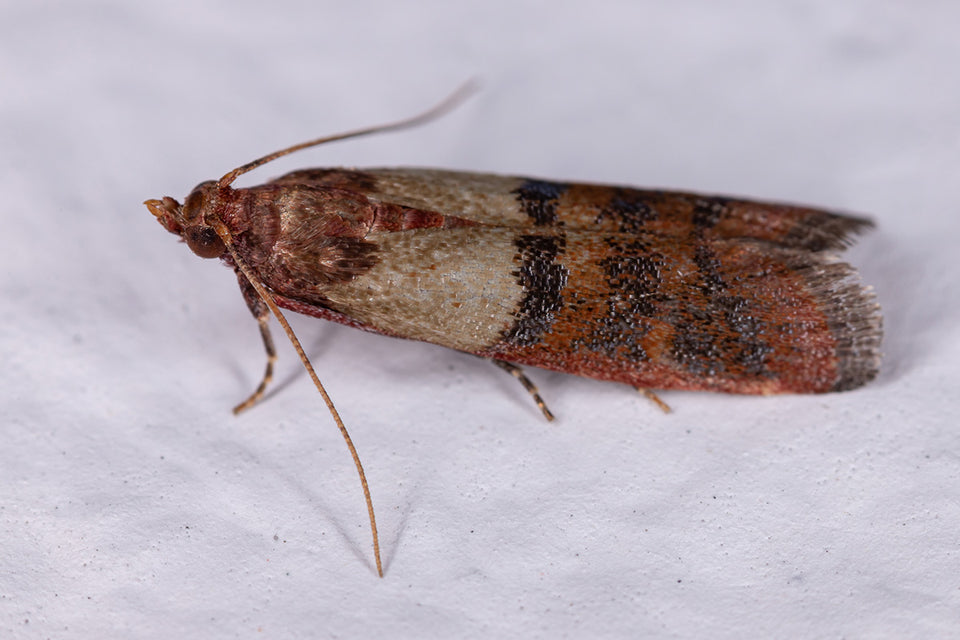
FAQs For How Do I Get Rid of Pantry Moths
Now that you have answers to the question of “How do I get rid of the moths in my pantry?” and we've discussed the process of naturally controlling and eliminating these insects, let's go over some frequently asked questions on Pantry Moth removal. That way, you'll be left with no doubts as you wage war on these unwelcome household pests.
What causes Pantry Moths?
Pantry Moths, sometimes also known as Indian Meal Moths, are pestilent insects that consume dry goods, grains, oats, and other similar food products. They infest and eat consumable goods in the larval stage. Adult female Pantry Moths tend to lay eggs in undisturbed places where abundant food sources for their larvae are present. Oftentimes, this ends up being in pantry spaces.
If you find moths in the pantry, it could also be because eggs were laid on the exterior of a food item’s packaging at a grocery store or even at a food processing facility. So, don't be too hard on yourself if you find moths in the pantry. These tenacious insects can be very intrusive and are quite persistent when it comes to your home’s invasion.
Common causes of Pantry Moths include:
- Keeping expired goods and unsealed food on pantry shelves
- Food that is left outside and then brought indoors later
- Buying bulk items that may have been exposed to the outdoors (like birdseed and dog food)
- Packaging from the store with eggs hidden in the crevices or corners
- Undisturbed dry goods that were somehow exposed to egg-laying female Pantry Moths during shipping or at a processing facility
Can you ever get rid of Pantry Moths?
You may be wondering: “How do I get rid of moths in the pantry once and for all?” Although an infestation of Pantry Moths may seem like an ongoing problem, it is definitely possible to eliminate the presence of these insects for good.
To permanently get rid of Pantry Moths, you will have to carefully deal with your infestation at its source. This often involves cleaning out all of your shelves, emptying drawers, wiping surfaces and walls, and scouring the outside of product packaging. Then, use moth deterrent methods to prevent these pesky nuisances from returning. If you can figure out where the moths came from in the first place, all the better.
What kills Pantry Moth Larvae instantly?
When you find yourself asking “How do I get rid of these moths in my pantry?”, it’s all about identifying the origin of the problem, eliminating infested goods, uncovering hidden larvae and eggs, and preventing the moths from coming back. With the right measures and efforts, you can resume cooking and enjoying the goods in your pantry without the fear of coming across moths again.
For an instant kill, cleaning containers using a solution of hot soapy water will instantly kill Pantry Moth Eggs.
Additionally, freezing items will kill moth eggs and moth larvae, although you must wait 72 hours for this method to be effective. Remember, although pesticides can be useful for killing moths, many store-bought insecticides are NOT safe to use in your kitchen or pantry. Instead, opt for natural methods. Pantry Moth Traps, for example, can be great for killing adult male moths which helps break the breeding cycle.
What will kill Pantry Moths?
You can wash unopened products or containers that you suspect may be harboring Pantry Moth Eggs with hot soapy water. Or, place potentially contaminated items in your freezer for 72 hours. This will effectively kill larvae and hidden eggs so that they can't hatch and perpetuate an infestation.
For killing adult Pantry Moths, Pantry Moth Traps can be incredibly effective. Certain moth traps are safe to use in the kitchen or pantry, as they implement a combination of natural but powerful female moth pheromones which attract the active adult male moths.
How do I get rid of moths in my pantry?
If you search the term “how do I get rid of small moths in my pantry” online, you will likely uncover a myriad of results. Sometimes, this can make the problem feel even more overwhelming.
Not to worry, getting rid of Pantry Moths isn’t incredibly hard. It just takes some perseverance. The solution to eliminating Pantry Moths essentially involves removing any infested items, cleaning your pantry thoroughly, and using preventative techniques to keep these annoying pests from coming back.
Here’s the gist of the process:
- Bag up and throw away any infested food items that are beyond salvaging.
- Start cleaning out your pantry from top to bottom.
- If you find items that you suspect may be infested but aren't necessarily worth throwing in the trash, freeze them for 72 hours to kill hidden eggs or larvae.
- Remember to wipe down all surfaces including the insides of drawers and the undersides of shelves
- After you have dealt with an infestation, use preventative measures like moth traps and regular cleaning to reduce the likelihood of a future moth infestation.
- If thorough cleaning and using Moth Traps does not eliminate the infestation completely please refer to our Pantry Moths Kit Guide for information on using human and pet-safe moth-killing sprays around your kitchen. Hot soapy water will often work just fine.
When it comes to Pantry Moths, the primary goal is to throw away infested goods and kill any larvae or eggs that may be hiding in your pantry. Then, use preemptive measures like moth traps to keep this problem from ever troubling you again.
About MothPrevention
MothPrevention® speak to customers every day about their clothes moth issues - clothes moths are a species that are ever increasing and that can cause significant damage to clothes, carpets and other home textiles.
To date, we’ve helped over 250,000 customers deal with their moth problems. We have developed professional grade solutions including proprietary pheromones and trap design, not available from anybody else in the USA.









